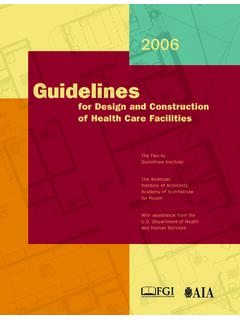Transcription of Hybrid Operating Room Design Basics - FGI
1 FACILITY GUIDELINES Operating Room Design Basics November 2018 Mary Fearon, MSN, RN, CNOR 2018 The Facility Guidelines the Facility Guidelines InstituteThe Facility Guidelines Institute is a not-for-profit corporation founded in 1998 to provide leadership and continuity to the revision process for the Guidelines for Design and Construction documents. FGI functions as the coordinating entity for development of the Guidelines series of documents using a multidisciplinary, consensus-based process and for provision of ancillary services that encourage and improve their application and use.
2 FGI invests revenue from sales of the Guidelines documents to fund the activities of the next revision cycle as well as research that can inform the Guidelines development DisclaimersThis document is provided for informational purposes only and is not and should not be construed as legal advice. The views and opinions expressed in this document are the opinions of the author and not the official position of FGI or the Health Guidelines Revision Committee. The information provided in this document may not apply to a reader s specific situation and is not a substitute for application of the reader s own independent judgment or the advice of a competent professional.
3 Neither FGI nor the author makes any guaranty or warranty as to the accuracy or completeness of any information contained in this document. FGI and the author disclaim liability for personal injury, property damage, or other damages of any kind, whether special, indirect, consequential, or compensatory, that may result directly or indirectly from use of or reliance on this Operating Room Design BasicsContentsPlanning and Design Tools 2 The Functional Program 4 FGI Guidelines for Design and Construction 4 AORN Guidelines for Perioperative Practice 6VA Design Guide 7 Design Considerations 7 Space Requirements 8 imaging equipment 11 Radiation Protection 13 Creating an Efficient Workflow 13 Acoustic Considerations 15 Restricted Environment 16 Challenges to Improve Design 16 Resources 18 About the Author 22
4 Hybrid Operating rOOm Design basics1A Hybrid Operating room (OR) combines the capabilities of an Operating room with the technologies of interventional imaging . With the combination of surgical facilities and imaging systems in one room, Hybrid ORs can be used for traditional open surgeries, image-guided surgeries, or a combination of procedure types, offering greater flexibility and utility of the ORs offer many benefits to patients, clinicians, and health care organizations. In particular, state-of-the-art Hybrid ORs facilitate provision of a broad range of procedures that are less invasive than traditional surgery and offer faster recovery times for patients.
5 For example, complex cardiovascular and endovascular conditions that formerly required open heart surgery are now being diagnosed and treated with less invasive surgery in Hybrid ORs. See Figure 1 for a representative list of procedures, by surgical specialty, typically performed in a Hybrid Operating Room Design BasicsHybrid Operating rOOm Design basics2 Figure 1: Procedures that May Be Performed in a Hybrid Operating Room*Surgical SpecialtyCardiovascularCardiothoracicNeu rovascularOtherAbdominal aortic aneurysm repairTranscatheter valve replacement (TAVR)
6 Coil embolization or microsurgical clipping of cerebral aneurysmsHemorrhage control in trauma patientsAortic stent graftingPercutaneous removal of cardiac device leadsIntracranial stenting of cerebral arteriesHigh-risk obstetricsCarotid stent graftingMinimally invasive endoscopic bypass surgeryCerebral balloon angioplastyOrthopedic traumaEndovascular aortic repair (EVAR)Minimally invasive direct coronary artery bypass graftingMicroneurosurgical resection of brain tumorsThoracic endovascular aortic repair (TEVAR)
7 Robotically enhanced minimally invasive direct coronary artery bypassCombined carotid surgical cutdown followed by endovascular coiling for bypass of tortuous anatomyPediatric aortic and pulmonary stenosisCombined arteriovenous malformation embolization followed by microneurosurgical resectionHypoplastic left heart syndrome treatmentCerebral vascular tumorsOff-pump coronary artery bypassSpinal vascular tumorsAtrial fibrillation/flutter ablationHybrid maze*These procedures are referenced in the asterisked citations in the Resources and Design ToolsThe inherent flexibility required of a Hybrid OR environment challenges the Design team to go beyond the Design requirements for such spaces to create an efficient work environment that can support the planned uses of the room and the operational complexity that comes from combining surgical and imaging services in the Hybrid Operating rOOm Design basics3same space.
8 To achieve the hoped-for clinical and cost benefits from building a Hybrid OR, careful planning is vital at the outset of a project. To help Design teams deliver a facility that supports a health care organization s goals, this white paper defines the purposes and types of Hybrid ORs, discusses facility planning and Design considerations, and looks ahead to future trends that will change the use of this type of of Hybrid ORsHybrid ORs are typically characterized by the type of imaging equipment installed in the room and the clinical services offered.
9 They can be found in cardiac catheterization suites, interventional imaging suites, and surgical suites. Regardless of where the room is located, the Hybrid OR Design must combine the requirements of an Operating room and an imaging room to allow the flexible use expected of a Hybrid equipment commonly installed in a Hybrid OR includes single-plane or biplane angiography equipment , computed tomography (CT) scanners, and magnetic resonance imaging (MRI) scanners. The single-plane system is the most commonly installed and is used for an array of cardiac and vascular multi-axial robotic angiography system is a single-plane system with eight rotational axes that provides more images at different angles without using biplane technology.
10 It provides images similar to a CT scan but offers more flexibility. These systems may be mounted on the floor or systems, which can acquire images from two reference points at the same time, have two C-arms one mounted on the floor and one on tracks in the ceiling. These systems are used most often for small-vessel angiography in pediatric patients and neuro-angiography and are required for neurosurgical cerebral endovascular procedures. Using two C-arms reduces the amount of radiation exposure and the need for contrast media.








